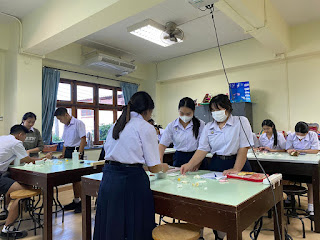Teaching Practice
1.1 Procedure of Teaching
The teaching activities were divided into three stages: pre-activity, whilst activity, and post activity.
- Pre-activity, the activities included orientation, apperception, and motivation. These were conducted to spark students' curiosity about the topic and boost their motivation to learn.
- Whilst activity served as the core part of the lesson. Here, students listened to the teacher's explanation before teaming up with classmates for a group activity involving an iodine test and completing the group worksheet.
- Post activity, the teacher assessed students' understanding through individual quizzes or games featuring questions related to the topic discussed. Finally, students presented their conclusions about the lesson.
1.2 Time management and organizing activities
Pre-activity (15 minutes)
Teacher
- Starting the lesson by greeting
- Checking attendance
- Gives an opportunity to one of the students to review the material learned previously.
- Shows a picture and asks students random questions about carbohydrates.
- Tells the lesson objectives
- Motivate students
Student
- Give the greeting
- Respond to the teacher’s presence
- One of students explained about the previous material, which was about the classification of carbohydrate types and carbohydrate structures.
- Students answer questions from the teacher
- Students listen the teacher
- Listen to motivation from the teacher
Whilst activity (60 minutes)
Teacher
- Shows the material in PPT about introduction and classification of carbohydrate and kinds of carbohydrate test.
- Explains the topic
- Divides students into groups
- Instructs students to do iodine test practice
- Gives the worksheet to the group
- Asks students to write the results on the whiteboard
- Discusses the results written by students
Student
- Look at the material
- Listen to the topic
- Get into groups in random order
- Do amylum test practicum in groups
- Work on the worksheet in groups
- Write the results on the whiteboard
- Listen to the teacher’s explanation
Post activity (25 minutes)
Teacher
- Asks students to do the quiz individually
- Determines the students who get the best 3 results
- Gives appreciation to all students
- Asks students to summarize today’s learning
- Closes the lesson
- Answer greeting
Student
- Take the quiz individually
- Listen to the teacher’s explanation
- Listen to the teacher’s explanation
- Make conclusions on the learning, discussion results and quizzes that have been done
- Give greeting to the teacher
1.3 Classroom Management
The teaching practicum was conducted in the third week in M. 4/1 and M. 4/2. The topic in the lessons was carbohydrates. The lesson plan was designed to prioritize active student participation in the learning process. The learning objectives, activities, teaching media, and student worksheets were formulated with approval from both the teacher and the lecturer.
Teaching practicum took place in the biology laboratory. Learning media and student worksheets as well as individual quiz were prepared in such a way by considering the needs of students. Group division is also prepared by considering the seating arrangement and the number of students. Equipment and materials are prepared in complete sets for each group so that all have the opportunity to carry out their own practicum in groups.
1.4 Problem solving when Teaching and Staying in Designated School
I had difficulty communicating with the cooperating teacher because she did not know English, but there were teachers and students who helped so that direct communication could be understood in both directions. In addition, google translate was also used to keep the communication going.
Language differences make it difficult to understand everything at school so many questions come to mind. Fortunately, there is a foreigner teacher who helps explain about various things that have not been understood.
During classroom learning from observation, teaching assistant and real teaching the students appeared enthusiastic and were able to follow the lessons effectively, although some students might have found it challenging to fully understand the explanations in English. So I tried my best to use Thai vocabulary and clear expressions so as to build a good interaction with the students.

.jpeg)

Comments
Post a Comment